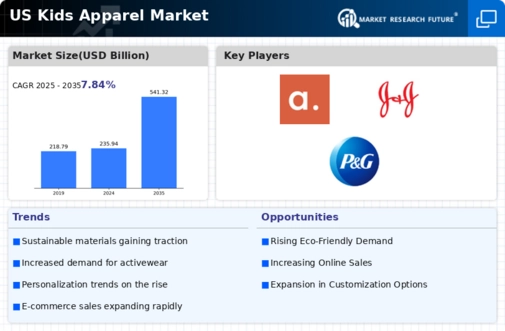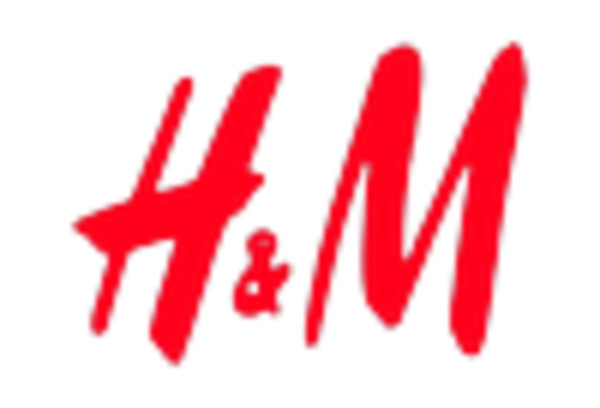The kids apparel market exhibits a dynamic competitive landscape characterized by rapid innovation and strategic maneuvering among key players. Companies such as Nike (US), Gap Inc. (US), and Carter's (US) are at the forefront, each adopting distinct strategies to enhance their market presence. Nike (US) continues to leverage its strong brand equity through innovative product lines and collaborations, while Gap Inc. (US) focuses on sustainability initiatives to appeal to environmentally conscious consumers. Carter's (US), known for its extensive range of children's clothing, emphasizes digital transformation to streamline operations and enhance customer engagement. Collectively, these strategies contribute to a competitive environment that is increasingly shaped by consumer preferences for quality, sustainability, and technological integration.
In terms of business tactics, companies are increasingly localizing manufacturing and optimizing supply chains to respond swiftly to market demands. The competitive structure of the market appears moderately fragmented, with several players vying for market share. However, the influence of major companies like Nike (US) and Gap Inc. (US) remains substantial, as they set trends that smaller brands often follow. This interplay of established and emerging brands fosters a vibrant market atmosphere, where innovation and responsiveness are critical.
In October 2025, Nike (US) announced a partnership with a leading tech firm to develop a new line of smart apparel for children, integrating wearable technology into their clothing. This strategic move not only positions Nike (US) as a pioneer in the intersection of fashion and technology but also caters to the growing demand for interactive and functional clothing among tech-savvy parents. The potential for increased customer engagement and brand loyalty through this innovation is significant, suggesting a forward-thinking approach to product development.
In September 2025, Gap Inc. (US) launched a new initiative aimed at reducing its carbon footprint by 30% by 2030, focusing on sustainable materials and ethical manufacturing practices. This commitment to sustainability resonates with a growing segment of consumers who prioritize eco-friendly products. By aligning its operational strategies with consumer values, Gap Inc. (US) not only enhances its brand image but also positions itself competitively in a market increasingly driven by sustainability concerns.
In August 2025, Carter's (US) unveiled a revamped e-commerce platform designed to enhance the online shopping experience for parents. This digital transformation effort includes personalized shopping features and improved logistics for faster delivery. By investing in technology to streamline operations, Carter's (US) aims to capture a larger share of the online market, which has become increasingly vital in the retail landscape. This strategic focus on e-commerce reflects a broader trend among retailers to adapt to changing consumer behaviors.
As of November 2025, the competitive trends in the kids apparel market are heavily influenced by digitalization, sustainability, and the integration of advanced technologies such as AI. Strategic alliances are becoming more prevalent, as companies seek to enhance their capabilities and market reach. The shift from price-based competition to a focus on innovation, technology, and supply chain reliability is evident. Moving forward, differentiation will likely hinge on the ability to innovate and respond to consumer demands for quality and sustainability, suggesting a transformative phase for the industry.

















Leave a Comment